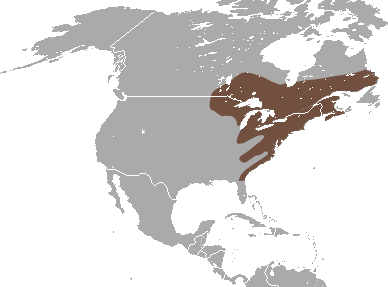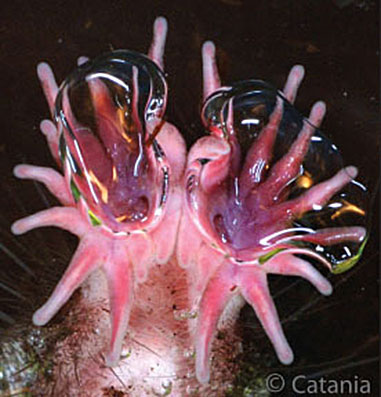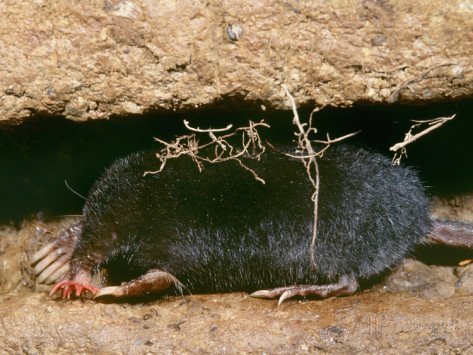Habitat
Condylura cristata lives in the moist soil of coniferous
and deciduous forests in the nearactic. This biogeographical region
is located in the northern portion of the western hemisphere.
 It
includes Greenland and all of North America down to central Mexico.
Specifically, Condylura cristata is found in northern and
eastern North America (Kurta 1995). These animals can be found as
far north as Québec, Canada, as far south as Georgia, USA and
throughout the Appalachian Mountains in between. Condylura
cristata is also found along the USA – Canadian border from the
Atlantic Coast into North Dakota, USA (Kurta 1995).
It
includes Greenland and all of North America down to central Mexico.
Specifically, Condylura cristata is found in northern and
eastern North America (Kurta 1995). These animals can be found as
far north as Québec, Canada, as far south as Georgia, USA and
throughout the Appalachian Mountains in between. Condylura
cristata is also found along the USA – Canadian border from the
Atlantic Coast into North Dakota, USA (Kurta 1995).
Condylura cristata prefers to live in riparian habitats and
is the only semi-aquatic mole in the western hemisphere (Campbell et
al. 1999). A riparian environment is an area of land that lies
alongside a body of water and has little drainage capabilities; this
could be a river, lake, swamp, or any other presence of water
(Natural Resources Conservation Service 2014). The characteristics
of this area are greatly impacted by the surrounding water. These
impacted areas include the vegetation, the soil and the water
itself. The soil, for the most part, is extremely damp and is full
of nutrients that the body of water has brought downstream (Natural
Resources Conservation Service 2014). Although this is the normal
homeland of Condylura cristata, they have also been sighted
in a variety of areas. They can survive happily in either warm or
cold environments and at many different elevations, the lowest being
the Atlantic coastline and the highest being into the Great Smoky
Mountains. These moles have also been seen sparingly in dry areas
miles from a body of water, but this is not typical
 (Kurta 1995).
(Kurta 1995).
This riparian habitat provides an optimal environment for the organisms that Condylura cristata feed on. The wet and nutritious soil is a great habitat for the worms and beetle larvae that Condylura cristata feeds on. Even though catching this prey might seem like the easiest way to acquire food, only 12-25 percent of their nutrients are taken this way (Saunders 1988). The other 75-88 percent are taken underwater, another reason that a riparian area is needed. This large portion of food consists of mostly aquatic invertebrates. Condylura cristata are also known to feed on small amphibians and fish (Saunders 1988). Condylura cristata can even smell underwater by creating bubbles from its nose, trapping particles and quickly bringing those bubbles and particles back in! Find out more about the organisms that Condylura cristata eats on the Interactions page!
Condylura cristata has a home range of approximately
4000 square meters and, like most talpids, it constructs and shares a network
of underground tunnels (Kurta 1995). The depth of these tunnels can
range between right at the surface to 60 cm deep (Saunders 1988).
 Throughout the tunnels, open, dry sections are made dug out to be
used as a nest for resting and for raising the young. Unlike many
talpids, this mole will create entrances to its den both above and
below the waterline; this allows it to quickly leave its burrow and
forage for aquatic invertebrates, in addition to any prey it finds
while digging (Saunders 1988). The underwater holes are often built
fairly deep in the water, which allows the mole to have continued
access to the water during the freeze of the winter (Saunders 1988).
The mole tunnels and dens also provide shelter from the predators of
Condylura cristata (Kurta 1995). Check out these predators on the
Interactions page!
Throughout the tunnels, open, dry sections are made dug out to be
used as a nest for resting and for raising the young. Unlike many
talpids, this mole will create entrances to its den both above and
below the waterline; this allows it to quickly leave its burrow and
forage for aquatic invertebrates, in addition to any prey it finds
while digging (Saunders 1988). The underwater holes are often built
fairly deep in the water, which allows the mole to have continued
access to the water during the freeze of the winter (Saunders 1988).
The mole tunnels and dens also provide shelter from the predators of
Condylura cristata (Kurta 1995). Check out these predators on the
Interactions page!
